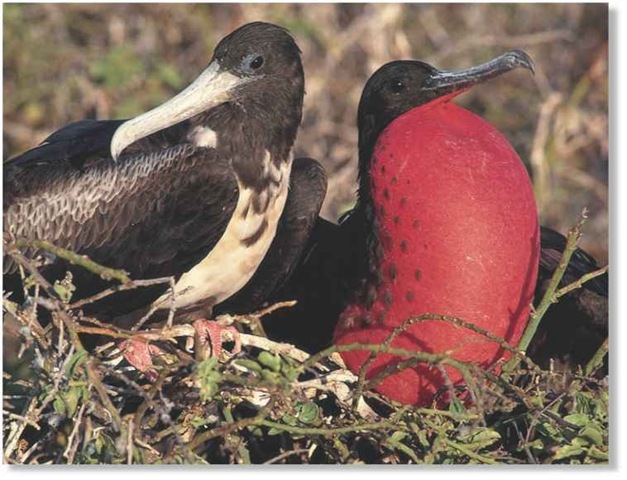ORDER
Pelecaniformes
FAMILY
Fregatidae
GENUS & SPECIES
KEY FEATURES
• An aggressive pirate of the skies, it forces other seabirds to give up their catch of fish
• Long wings, a streamlined shape and low weight give it great maneuverability in the air
• Snatches fish from the sea’s surface and steals eggs and chicks from other birds’ nests
WHERE IN THE WORLD!
Along coasts from Florida to Brazil and Baja California to Ecuador; on the Galapagos Islands and off the West African coast on the Cape Verde Islands

Lifecycle
Despite being a poor swimmer and lacking waterproof feathers, the magnificent frigatebird is an ocean predator, notorious as a fearless pirate of the tropical seas.
Habitat
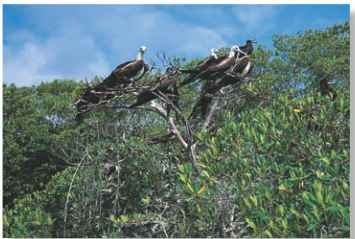
A Local branch Mangroves are popular roosting and nesting sites.
The frigatebird is found along the tropical coasts of the Americas and western Africa. Warm trade winds, which
blow year-round with variable force toward the equator, have an influence on its distribution. These winds produce thermals night and day, letting the frigatebird soar freely while searching for squid, a favorite food, which come close to the sea’s surface at night.
The frigatebird is closely tied to mainland coastal areas and is rarely seen midocean. It breeds along coasts or on small offshore islands, especially in stands of mangrove trees. On the Galapagos Islands, it may even nest in a large cactus plant. Where vegetation is scarce, such as on the Cape Verde Islands, off West Africa, the frigatebird may be forced to construct a nest on the bare ground.
“Frigatebird” may come from the comparison of the bird to the fast frigate ships once used by pirates to attack merchant vessels.
The magnificent frigatebird has the highest wingspan-to-weight ratio of all seabirds. The skeleton is less than 5% of total weight.
Conservation
With a world population of several hundred thousand, the magnificent frigatebird isn’t under threat, but habitat destruction is a potential danger.The tiny colony on the Cape Verde Islands has been reduced to about 12 pairs. Precise figures are difficult to assess because some non-breeding birds remain at sea in the nesting season.
Behavior
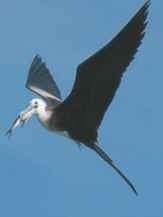
A Fish out of water A juvenile swallows its catch, head first, in flight.
Food & feeding
The frigatebird follows schools of dolphins or tuna and uses its agility to snatch fish that break surface to escape underwater predators. Squid and jellyfish are also part of its diet. These are usually taken in a more leisurely fashion; the frigatebird drifts down from a height to grab its prey from the surface of the sea.
Seabirds’ eggs and chicks, particularly those of terns, are plundered from nesting colonies, and hatchling turtles are scooped up from the beaches. Magnificent frigatebirds have, like many other seabirds, learned to exploit the opportunities presented by humans and will follow fishing boats to feed on the scraps and offal thrown overboard.
The frigatebird’s reputation rests on its spectacular pursuit of other seabirds, harassing them until they give up their catch.
booby prize

Unsuspecting…
A red-footed booby returns from a successful fishing trip, as yet unaware of the aerial pirate about to swoop to the attack.
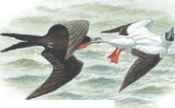
Pirate ahoy…
Using its superior flying skills, the frigatebird homes in on its victim, tugging fiercely at its wing and tail feathers with its sharp bill.
Leaving its roost on land in early morning, the frigatebird soars out to sea in search of food. It forages alone, but may congregate around concentrated sources of food, such as fishing boats. When not soaring, it rests on perches provided by ships’ masts, buoys and fishing posts.
Dissipating excess heat is a problem for birds in tropical climates, but the frigatebird prevents overheating in a couple of ways. Males and females use ‘gularfluttering.’ This is similar to panting and involves the bird passing air over the mucous membranes in its throat. Mucus then evaporates, causing heat loss. Also, by ruffling its feathers, the bird lets the breeze draw heat directly away from its skin.
Unlike most other seabirds, the frigatebird drinks freshwater when it has the opportunity flying low over the surface and scooping water into its bill.
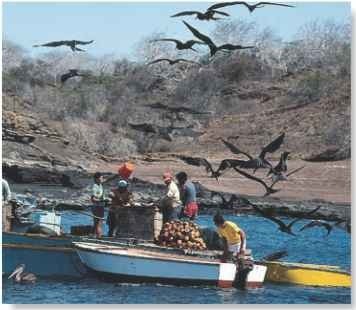
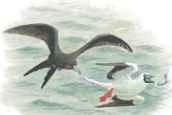
Boarding party…
In danger of injury through being knocked out of the sky, the harassed booby regurgitates part or all of its fish load and quickly flies off.

Booty
As the prize falls rapidly to the sea, the frigatebird dives after it, swooping down and deftly catching the fish in midair.
Breeding
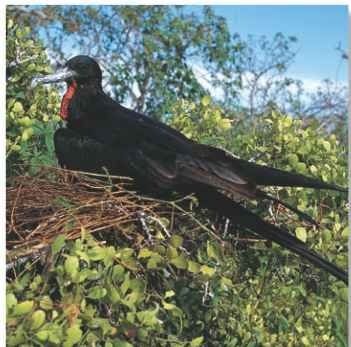
A Home to roost When this male attracts a mate, the female will organize the nest and add material of her own.
The cue for the frigatebird to start breeding arrives when the trade winds begin to blow strongly. Then, the male collects twigs, leaves and seaweed for the female who constructs a flimsy nest platform, usually 7-17′ up in a tree. Frigatebirds often nest close to each other to form a colony. Both parents incubate the egg and feed the chick when it hatches. Adults may have difficulty catching enough food to feed their young and often resort to stealing it from other birds.
The frigatebird has one of the longest breeding cycles of all seabirds because of the chick’s slow development and the long period of care (5-7 months) needed after leaving the nest. The female breeds only once every two years.
Feather weight The single chick is naked on hatching, but soon develops fluffy white down.
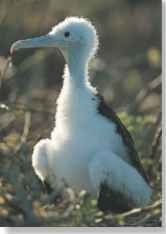
PROFILE
Magnificent Frigatebird
Well adapted to an aerial existence, the magnificent frigatebird is a marauder of the tropical coasts of North and South America.

Creature comparisons
The red-footed booby (Sula sula) has the same range as the magnificent frigatebird and often nests in the same colony.The frigatebird is very buoyant in the air; the booby appears cumbersome, with its heavy body and labored flight. When feeding, the booby dives vertically from 30-100′ into the sea, submerging itself for fish and propelling itself by its webbed feet. Unlike the frigatebird, which rarely gets wet, the booby has well-developed oil glands above the tail that provide essential waterproofing.
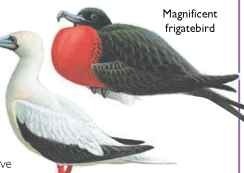
Red-footed booby
| VITAL STATISTICS | |
| Weight | 2-3 lbs. |
| Length | 3-4′ |
| Wingspan | 7-8′ |
| Breeding Season | Throughout the year; in some locations favors dry season . |
| Number of Eggs | 1 |
| Incubation Period | 40-50 days |
| Fledgling Period | 20-24 weeks |
| = Breeding Interval | 2 years |
| Typical [Diet Lifespan |
Flying fish, squid, offal, scraps, seabird eggs and chicks Up to 30 years; average 12-15 |
RELATED SPECIES
There are five species of frigatebird in the genus Fregata; great frigatebird (Fregata minor) has the widest distribution.. aquila is confined to breeding on Ascension Island and F. andrewsi to Christmas Island. The smallest is the lesser frigatebird, F. ariel. Frigatebirds belong to the Pelecaniformes order, which also includes pelicans, gannets, boobies and cormorants.
